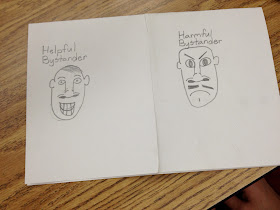Bullies select and systematically train their victims to comply to their demands. They seek active encouragement, passive acceptance, or silence from bystanders. But, bullies can be stopped when victims and bystanders learn and apply new ways to stand up against bullying. Bullies can also learn how to make friends and get what they want by helping, rather than hurting, others.
Victims reward the bully by yielding control and showing signs of intimidation. They often fail to gain support form bystanders and avoid reporting the bullying. But, victims can learn to defeat the bully by responding assertively, rallying support from bystanders, or reporting the bullying to adults.
Bystanders play an important and pivotal role in promoting or preventing bullying. Often without realizing it, they may exacerbate a situation by providing an audience, maintaining silence, actively encouraging, or joining in. But, bystanders can neutralize or stop the bullying by aiding the victim, drawing support from other bystanders, or obtaining help from adults.
In 4th and 5th grade, we read One by Kathryn Otoshi. This book has beautifully simple illustrations that bring attention to a highly sensitive issue: bullying. In the story, the color blue is bullied by the color red. The other colors are harmful bystanders until the number "1" comes along to show them how to be a helpful bystander. This reinforces the fact that it only takes one.
As a class we discussed the importance of bystanders and why don't more bystanders intervene when they are witness to bullying. Student reply that they often fear getting hurt or becoming the next victim, feel powerless, think it's none of their business, don't know what to do, don't like the victim, don't want to draw attention to themselves, etc. Bystanders who don't intervene or don't report the bullying often suffer negative consequences themselves, such as pressure to participate in the bullying, vulnerability to being victimized, guilt for not having defended the victim, or even anxiety about speaking to anyone about the bullying.
We then created a flip book to describe the two types of bystanders. Helpful bystanders don't always have to speak up to the bully. If they are afraid to ask them to stop they can stand next to the victim, walk them to get help, or invite them to play another game.
Lesson information adapted from "The Bully Free Classroom" and www.eyesonbullying.org






No comments:
Post a Comment